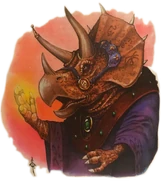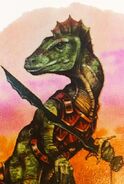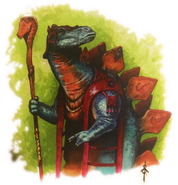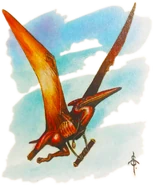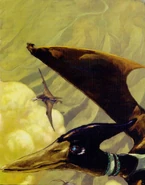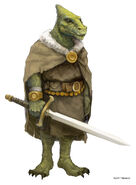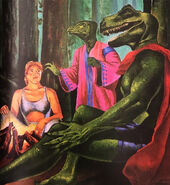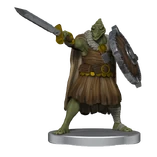However, if you can update it or think of a way to further improve it, then please feel free to contribute.
Saurials were a rare breed of scalykind—specifically a "sauroid" race—not native to Toril. Several subraces existed, though only four were found on Toril itself, dwelling in the Lost Vale, also known as Tarkhaldale, in the Desertsmouth Mountains.[11] A second group, named lacerials, lived on the Malatran Plateau in southern Kara-Tur, and the Valley of Spirits before that.[2][note 1]
Description[]
Saurials were intelligent bipedal humanoids who descended from dinosaur-like creatures of an unknown crystal sphere. On Toril, only four types of saurials existed: bladebacks, finheads, flyers, and hornheads—all names given to them by the natives of the Realms. Their names in the saurial language were combinations of noises, chirps, and scents, unreplicable by mammalian humanoids.[6]
All the saurial types possessed fine brightly colored scales of various hues from tan brown to green and aquamarine. The scales on their backs formed patterns unique to each subrace. Each of the saurial types occasionally produced individuals born with albinism. All had sharp claws and tails, but otherwise their bodies were considerably different.[6]
- Finheads:[13] The most human-shaped of the saurials, they were generally shorter than an average human, standing around 5 feet (1.5 meters) with a long tail. Finheads were named for a prominent fin on the tops of their heads. They had muscular and agile bodies and often became fighters and paladins.[6]
- Bladebacks:[14] Taller and bulkier than finhead saurials, they grew up to 7 feet (2.1 meters) and had rows of sharp bone-hard scale protrusions running from the tops of their heads, down their backs, and all the way to the tips of their tails.[6]
- Flyers:[15] The smallest of the saurials at 3 feet and 8 inches (1.1 meters). They had thin and delicate bodies, short legs, stubby tails, and hands with large stretches of skin that formed wings. Although clumsy and slow on land, they moved with speed and grace in the air. Rarely, flyers had bright red spots around their necks.[6]
- Hornheads:[16] The largest of the saurials, hornheads grew up to 10 feet (3 meters) tall. They had powerful thick tails that were longer than their bodies, sturdy bulky frames, long sharp horns on their heads and crests of tough bony plates that protected their necks. Despite their intimidating physique, these saurials were the most likely to take on a spellcaster's mantle.[6]
Abilities[]
Saurials possessed true infravision and could see heat wavelengths at 60 feet (18 meters).[8] However, they could not detect cold objects in the dark.[6]
They possessed natural resistance to sound-based attacks and effects, including the shout spell and a harpy's charming song. However, they were naturally vulnerable to gas-based attacks and effects, such as cloudkill or various gaseous poisons.[6]
Unlike true lizards, saurials were warm-blooded,[11] but still could not keep their bodies warm as well as mammals could. When exposed to freezing temperatures, saurials went into a torpor referred to as "cold sleep". Their breathing and heartbeat slowed to such a low level that others could assume them dead. The smaller the saurial was, the easier and faster they succumbed to cold sleep: flyers could pass out after just 30 minutes in the cold, while finheads after 50. Warm insulating clothing doubled this time. They revived only after returning to a warm environment within an hour or two. Otherwise, the cold sleep was dangerous indeed; if exposed to freezing temperatures for a day, the saurial died.[6]
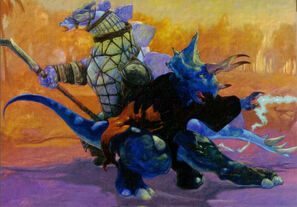
Hornhead and bladeback saurial spellcasters in action.
Magic[]
The saurial homeworld had both arcane and divine magic. Their natural attributes aided them in pursuit of the Art and the Power.[17]
Saurial paladins possessed an ability called shen sight, somewhat similar to Toril's divine sense. It granted saurial paladins a second sight that allowed them to see individuals' thoughts, feelings, desires, goals, even into the spirit and the soul. The soul appeared to the paladin in complex swirls of forms and colors: gray was the color of neutrality, purples and reds indicated evil, a black void represented evil undead creatures, blue the powers of good, and yellow meant greed. The clarity of the colors indicated the purity of the soul.[18]
Personality[]
Each of the saurial subraces treated each other with equality and respect, using each group's natural talents to maximize the community's accomplishments. Because none of the different subraces of saurials could interbreed, however, most households were homogeneous.[19]
They befriended others with ease and only rarely made enemies, though they were quick to respond if there was an obvious danger. Mates and siblings shared much stronger bonds than other humanoids and protected one another from harm whenever possible.[17]
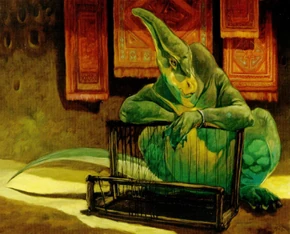
A finhead saurial crafter.
- Finheads tended to be smart, curious, and emotional. They often had a black-and-white view of morality and the world. Finheads were excitable when facing new tasks and experiences, often charging headfirst into dangerous situations. This personality made adventuring saurials found outside of the Lost Vale very likely to be a finhead.[6]
- Hornheads were prone to slow, careful, rational thinking and had impeccable planning and analytical skills. They spoke slowly, carefully choosing every word. Hornheads had a knack for arts, sciences, and crafts that involved physical strength. Like any other race in the Realms, hornheads could be of any vocation, but generally, they swayed towards being clerics, wizards, and sorcerers.[6]
- Bladebacks were highly social beings who loved diverse company and engaging conversation. They tended to be trusting and direct while being empathetic and understanding. Usually, it was hard to anger bladebacks, but if they were pushed to anger or wronged somehow, they were slow to forgive. Bladebacks often took on positions of leadership, advisory roles, and clergy.[6]
- Flyers were small, quick, curious, nervous, and both irritable and irritating. They often preferred flight to fight and loved conversation and gossip. Most commonly, flyers took on the roles of messengers, scouts, fighters, and rogues. However, many flyers defied stereotypes throughout saurial history, which was one of the things flyers loved to mention in conversation.[6]
Combat[]
Saurials, when forced into combat, used a wide variety of skills and weapons according to their profession. The most often-used types of blades, crafted by and for saurials, had short grips and diamond-shaped barbed tips. Most other races found them difficult and uncomfortable to handle, while saurials found other humanoids' weapons similarly difficult.[6]
Even unarmed, saurials were far from defenseless. Most were trained in ancient martial arts that involved the use of their claws, tails, bites, and/or horns.[6]
Saurials had a thick protective natural hide but were known to outfit themselves with sturdier armor when pressed, even though wearing it was somewhat alien to them.[6]
Society[]
Many heroes and defenders of the saurial tribe found in the Lost Vale perished battling the god of decay Moander before they were transported to Toril. The surviving tribespeople were simple villagers—hunters, farmers, and craftspeople including weavers, carpenters, masons, blacksmiths, and musicians. The Lost Vale tribe also lost all their young during the time of their enslavement. After Moander's demise, saurials resumed procreation and peaceful lives. That experience left the first generation of saurials with somber attitudes and heavy memories, but they looked with hope at the young.[6]
Due to the trauma, the older generations remained mostly isolated but never xenophobic. On the other hand, the younger generations showed curiosity about the larger world, and some chose to venture outside the Vale, exploring and adventuring. Due to their community-centric culture, those young saurial adventurers often found a group to stick with, creating strong bonds with them.[21]
Culture[]
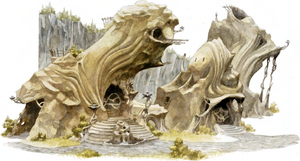
A typical saurial village.
In their daily lives, saurials rarely wore anything but loincloths and simple cloaks when they resided in places with a tropical climate. They wore decorated robes, crafted out of various fabrics and animal hides, during cultural ceremonies and events. They could wear armor but preferred not to because of how restricting and uncomfortable it was.[6]
Oftentimes, saurials decorated their bodies, scales, and bone plates with carvings and tattoos, especially the spellcasters, depending on the subrace and the body part decorated.[6]
Home & Family[]
After 1358 DR, saurials settled in the Lost Vale, their population numbering only 110 and consisting of various subraces of saurials who lived in peace and mutual respect. They considered themselves to be one tribe. Saurials of the Lost Vale tribe did not venture far from their home in the early years after forming their new community, but that changed with passing years and growing numbers.[6]
Saurials liked decorating their habitats with carpets and wall tapestries.[6] They knew how to work metal, crafting curiously shaped saurial broadswords[22] and enchanted swords similar to holy avengers that could negate magic on command.[23]
Saurials preferred single-family homes. A typical house was solidly built using wood and stone, with heavy insulation to protect them during winter. The homes were built one room at a time as the need for space arose.[6]
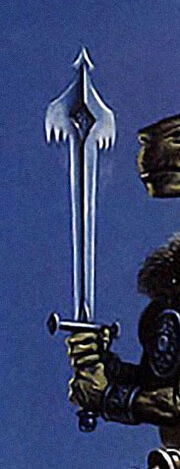
Saurial broadsword.
Saurials tended to mate for life, producing one or two eggs a year. Both males and females cared for the egg, by keeping it safe and warm and, later, raising, feeding, and teaching the hatchling. Saurials reached adulthood at the age of five, but it took them much longer to achieve emotional and intelligent maturity, akin to human youth. They had a long lifespan, with some individuals living for much longer than 200 years (sages did not know the exact life expectancy of a saurial, but theorized they could live as long as a dwarf,[24] but in 1357 DR, the saurial leader Grypht was already far past 200 years old without the use of magic promoting longevity).[6]
The bigger subraces needed to consume a lot of vegetation to survive, which limited the numbers of saurials a piece of land could support.[6]
Lacerials of the Malatran Plateau in Kara-Tur, lived in the village of Lilac, situated on a bank of the River of Laughing Idols.[25] Usually peaceful people, Malatran saurials were often avoided by their neighbors due to misguided conflicts between the communities, before lacerials moved to Malatra. They were given a derogatory nickname - Garuda-People.[3] Lacerials introduced cotton and hemp-woven clothes and crafted hide armor to the Malatran Plateau.[3]
Religion[]
Most saurials were spiritual and worshiped either Finder Wyvernspur, Chauntea,[6] Tymora, or Tyr.[26] Finder was their patron deity and the rescuer of their species,[1] while the other three reflected aspects of their ancestral gods.[26]
After suffering in Moander's rotten grasp, many saurials developed a superstitious fear of evil deities.[8]
The most respected members of saurial society were the "soul singers", a unique type of bard that preferred divination magic and had a mystical connection to their tribe. These bards experienced the tribe's well-being or strife via songs they performed.[24] When the soul singer sang while their tribe was suffering, the song's words and melody changed to reflect the pain. Soul singers were born with the gift, which was passed along family lines. In 1358 DR, Alias discovered herself to be a soul singer because she shared a soul with a saurial paladin Dragonbait. In the fifteen years that followed, the Lost Vale tribe birthed seven soul singers, an unprecedentedly high number.[24][27]
The lacerials of Malatra no longer had priests, having been abandoned by their original gods when abducted to Toril. Many of them felt a spiritual emptiness as a result, but former religious leaders became shamans worshiping nature spirits.[2]
Language[]
Saurials were physiologically unable to speak any language found on Toril.[6][28] Their voices were naturally pitched too high for most humanoids to hear, and frequently humans assumed them mute. Saurials punctuated their speech with scents that defined emotions[17][29] and bird-like chirps. Interestingly enough, the saurial language had some commonalities with Draconic, making it possible for dragons to communicate with saurials.[30] Some fey could also hear saurial voices, and while they didn't necessarily understand the language, they could understand the emotions associated with the scents.[29] It was possible for some dedicated individuals to train themselves to speak in audible tones, allowing them to communicate in the languages of Toril.[29]
Other creatures could interpret some of the common, stronger scents to understand the mood of a saurial. The scent of sulfur meant confusion, the aroma of roses meant sadness, lemons communicated pleasure or joy, baked bread indicated anger, violets meant danger or fear, honeysuckle meant tenderness, wood smoke conveyed devotion or piety, tar stood for victory, and the smell of ham meant nervousness or worry.[17][29]
Saurials did develop a form of writing that was very simplistic in appearance. They carved lines and etches on sticks. This form of communication was mostly used by spell-casters and for record-keeping.[6] Saurial wizards used notched sticks as spellbooks, some people unfamiliar with saurial language confused those spellbook sticks with staves.[31]
Saurial Names[]
Saurials used their language along with a scent for their names. They used objects and concepts of value or importance to name their hatchlings, instead of using abstract names that bore no meaning. The names used for them in Common were either loose translations or nicknames. Saurials were comfortable using nicknames if they couldn't find a suitable translation when among other creatures and cultures. When around kin, they used saurial language names.[32]
History[]
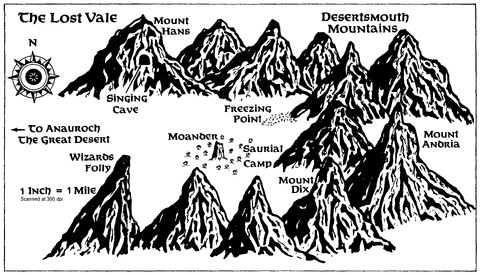
The home of the saurials on Toril, the Lost Vale.
The first saurial to be brought to Toril was the paladin Dragonbait. In 1357 DR, Phalse captured him as part of the complex arcane process to create Alias. The god of rot Moander was a part of the alliance of dark powers that joined together to create their perfect construct weapon.[33] After Moander's avatar was destroyed by Alias, Dragonbait, and their friends, Moander used the last of his divine powers in the Realms to find Dragonbait's world of origin.[34]
This led to the saurial community Dragonbait hailed from being brought to Toril by Moander in 1358 DR. The evil deity settled his new slaves in a place called the Lost Vale, a hidden locale near the Dalelands.[19] He corrupted the saurials with the seed of Moander, forcing them to destroy all living things in the area, including their own eggs, to rebuild Moander's power in the Realms. The deity used Dragonbait's old lover Coral as his main pawn, the Mouth of Moander. However, his plan failed as Finder Wyvernspur, Dragonbait, and Alias found a way to destroy Moander, freeing the saurials from enslavement. Coral, unfortunately, was irreversibly rotted from the inside by the god's corrupting vines and was released from her torturous existence by Dragonbait. The surviving saurials, with Elminster's aid,[33] decided to build a life for themselves on Toril, restoring what Moander had forced them to destroy. The Lost Vale was turned into a permanent settlement as a result.[6]
In 1363 DR, a group of six finhead saurials resided in the jungles of Chult, having been transported there years prior by a helpful wizard. That group was not aggressive but proficient in jungle survival. They spoke in a mix of saurial, Batiri, and monkey spider languages.[10]
By 1373 DR,[1] saurials were becoming less reclusive, on occasion leaving the Vale to trade and travel.[33] They remained mostly unwitnessed by the people of neighboring regions. Still, the stories of the curious "dragonfolk" were spreading further and further out from the Dalelands. By 1373 DR, the number of members of the Lost Vale tribe increased dramatically from the original 110 to 485 individuals.[1]
By 1479 DR, saurials had multiple settlements throughout the Lost Vale. But with the return of the empire Netheril to northern Faerûn and taking control of Tarkhaldale, many of the "dragonfolk" were driven underground.[35]
Notable Saurials[]
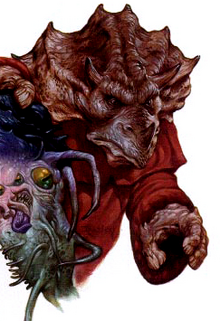
A hornhead saurial in a wizardly robe.
- Blackflame and Whiteheart: The leaders of the two enemy factions of lacerials in the Valley of Spirits[2]
- Copperbloom: A finhead cleric of Finder Wyvernspur[1] and Dragonbait's mate whom he met after Moander's destruction. They sired three hatchlings together,[36] the oldest was named Handful.[37]
- Coral: A finhead saurial cleric, Dragonbait's lover, and a victim of Moander's corruption.[34]
- Dragonbait: Also known as the Champion among the saurials. He was the "soul brother" and a traveling companion of Alias, as well as the protector of the Lost Vale.[6]
- Grypht: A hornhead wizard who led the community of the Lost Vale from 1358 to 1373 DR,[1] and possibly much later. He was the tribe's protector who played the key role in defeating Moander. He had three apprentices.[6]
- Rex: A bladeback saurial who claimed to be the Lost Vale tribe's leader before their arrival on Toril.[38]
- Sweetleaf: A bladeback cleric who worshiped the saurial world's goddess of harvest and agriculture. Chauntea answered her prayers while on Toril. Sweetleaf had five acolytes.[6]
- Trueblood: A hornhead and leader of the lacerials of Malatra after their flight from the Valley of Spirits; he was supported by Quickwing, a flyer rogue, Starr, a bladeback shaman, and Strongarm, a bladeback fighter.[2]
Appendix[]
See Also[]
Notes[]
- ↑ The lacerials were introduced in the Living Jungle setting by the RPGA network to go along with their Living Story campaign. They were identical to the saurials of Faerûn, but at the time, the RPGA was not allowed to use the term "saurial".
Appearances[]
- Adventures
- Curse of the Azure Bonds • Tomb of Annihilation
- Referenced only
- "The Runes of Chaos"
- Novels
- Azure Bonds • Song of the Saurials • Masquerades • Finder's Bane • Once Around the Realms
- Referenced only
- The Ring of Winter • The Sorcerer • The Maelstrom's Eye
- Comics
- Forgotten Realms (#2, #3, #4, #24)
- Video Games
- Curse of the Azure Bonds • Eye of the Beholder III: Assault on Myth Drannor • Tales from Candlekeep: Tomb of Annihilation • Idle Champions of the Forgotten Realms
- Board Games
- Tomb of Annihilation
- Card Games
- AD&D Trading Cards • Spellfire (1st • 2nd • 3rd • 4th)
- Organized Play & Licensed Adventures
- Death from the Mists
Gallery[]
References[]
- ↑ 1.0 1.1 1.2 1.3 1.4 1.5 Darrin Drader and Sean K. Reynolds (2004-07-17). Saurials: More Lizardkin (Zipped PDF). Web Enhancement for Serpent Kingdoms. Wizards of the Coast. p. 1. Archived from the original on 2016-11-01. Retrieved on 2018-09-11.
- ↑ 2.0 2.1 2.2 2.3 2.4 Stephen H. Jay, Robert Farnsworth (January 2000). Living Jungle Campaign: Player Information Guide (PDF). Living Jungle (RPGA), pp. 31–32.
- ↑ 3.0 3.1 3.2 Stephen H. Jay, et al. (January 2003). Inhabitants of the Jungle (PDF). Edited by Stephen Gryphon. Living Jungle (RPGA), p. 13.
- ↑ Christopher Perkins, Will Doyle, Steve Winter (September 19, 2017). Tomb of Annihilation. Edited by Michele Carter, Scott Fitzgerald Gray. (Wizards of the Coast), pp. 217–218. ISBN 978-0-7869-6610-3.
- ↑ 5.0 5.1 5.2 5.3 5.4 Darrin Drader and Sean K. Reynolds (2004-07-17). Saurials: More Lizardkin (Zipped PDF). Web Enhancement for Serpent Kingdoms. Wizards of the Coast. pp. 5–8. Archived from the original on 2016-11-01. Retrieved on 2018-09-11.
- ↑ 6.00 6.01 6.02 6.03 6.04 6.05 6.06 6.07 6.08 6.09 6.10 6.11 6.12 6.13 6.14 6.15 6.16 6.17 6.18 6.19 6.20 6.21 6.22 6.23 6.24 6.25 6.26 6.27 6.28 6.29 6.30 6.31 6.32 6.33 Jon Pickens ed. (November 1996). Monstrous Compendium Annual Volume Three. (Wizards of the Coast), pp. 90–92. ISBN 0786904496.
- ↑ Darrin Drader and Sean K. Reynolds (2004-07-17). Saurials: More Lizardkin (Zipped PDF). Web Enhancement for Serpent Kingdoms. Wizards of the Coast. p. 4. Archived from the original on 2016-11-01. Retrieved on 2018-09-11.
- ↑ 8.0 8.1 8.2 Bill Slavicsek (1993). The Complete Book of Humanoids. (TSR, Inc), p. 58. ISBN 1-5607-6611-5.
- ↑ Darrin Drader and Sean K. Reynolds (2004-07-17). Saurials: More Lizardkin (Zipped PDF). Web Enhancement for Serpent Kingdoms. Wizards of the Coast. pp. 1–3. Archived from the original on 2016-11-01. Retrieved on 2018-09-11.
- ↑ 10.0 10.1 James Lowder, Jean Rabe (1993). The Jungles of Chult. (TSR, Inc), p. 34. ISBN 1-5607-6605-0.
- ↑ 11.0 11.1 David Cook (1991). Monstrous Compendium Forgotten Realms Appendix (MC11). (TSR, Inc), p. 53. ISBN l-56076-111-3.
- ↑ Jeff Grubb, Kate Novak (March 1991). Song of the Saurials. (TSR, Inc.), chap. 3. ISBN 1-56076-060-5.
- ↑ Darrin Drader and Sean K Reynolds (2004-07-17). Saurials: More Lizardkin for Serpent Kingdoms (PDF). Wizards of the Coast. p. 6. Retrieved on 2018-11-03.
- ↑ Darrin Drader and Sean K Reynolds (2004-07-17). Saurials: More Lizardkin for Serpent Kingdoms (PDF). Wizards of the Coast. p. 5. Retrieved on 2018-11-03.
- ↑ Darrin Drader and Sean K Reynolds (2004-07-17). Saurials: More Lizardkin for Serpent Kingdoms (PDF). Wizards of the Coast. p. 7. Retrieved on 2018-11-03.
- ↑ Darrin Drader and Sean K Reynolds (2004-07-17). Saurials: More Lizardkin for Serpent Kingdoms (PDF). Wizards of the Coast. p. 8. Retrieved on 2018-11-03.
- ↑ 17.0 17.1 17.2 17.3 Darrin Drader and Sean K Reynolds (2004-07-17). Saurials: More Lizardkin for Serpent Kingdoms (PDF). Wizards of the Coast. p. 3. Retrieved on 2018-11-03.
- ↑ Dale Donovan, Paul Culotta (August 1996). Heroes' Lorebook. (TSR, Inc), p. 44. ISBN 0-7869-0412-7.
- ↑ 19.0 19.1 Darrin Drader and Sean K Reynolds (2004-07-17). Saurials: More Lizardkin for Serpent Kingdoms (PDF). Wizards of the Coast. p. 2. Retrieved on 2018-11-03.
- ↑ Richard Baker (1993). The Dalelands. (TSR, Inc), p. 48. ISBN 978-1560766674.
- ↑ Darrin Drader and Sean K. Reynolds (2004-07-17). Saurials: More Lizardkin (Zipped PDF). Web Enhancement for Serpent Kingdoms. Wizards of the Coast. p. 2. Archived from the original on 2016-11-01. Retrieved on 2018-09-11.
- ↑ Ed Greenwood, et al (1989). Hall of Heroes. (TSR, Inc), p. 23. ISBN 0-88038-711-4.
- ↑ Jeff Grubb, Kate Novak (October 1988). Azure Bonds. (TSR, Inc.), p. 345. ISBN 0-88038-612-6.
- ↑ 24.0 24.1 24.2 Sean K. Reynolds (February 2002). “Lords of the Lost Vale”. In Jesse Decker ed. Dragon #292 (Wizards of the Coast), p. 38. Archived from the original on 2016-10-02. Retrieved on 2009-08-19.
- ↑ Tom Prusa (December 1999). The Courage of a Coward (PDF). Living Jungle (RPGA).
- ↑ 26.0 26.1 Darrin Drader and Sean K Reynolds (2004-07-17). Saurials: More Lizardkin for Serpent Kingdoms (PDF). Wizards of the Coast. p. 4. Retrieved on 2018-11-03.
- ↑ Dale Donovan, Paul Culotta (August 1996). Heroes' Lorebook. (TSR, Inc), p. 11. ISBN 0-7869-0412-7.
- ↑ Dale Donovan, Paul Culotta (August 1996). Heroes' Lorebook. (TSR, Inc), p. 41. ISBN 0-7869-0412-7.
- ↑ 29.0 29.1 29.2 29.3 Sean K. Reynolds (February 2002). “Lords of the Lost Vale”. In Jesse Decker ed. Dragon #292 (Wizards of the Coast), pp. 36–43. Archived from the original on 2016-10-02. Retrieved on 2009-08-19.
- ↑ Jeff Grubb, Kate Novak (October 1988). Azure Bonds. (TSR, Inc.), chap. 21, pp. 247–255. ISBN 0-88038-612-6.
- ↑ Bill Slavicsek (1993). The Complete Book of Humanoids. (TSR, Inc), p. 57. ISBN 1-5607-6611-5.
- ↑ Sean K. Reynolds (February 2002). “Lords of the Lost Vale”. In Jesse Decker ed. Dragon #292 (Wizards of the Coast), p. 39. Archived from the original on 2016-10-02. Retrieved on 2009-08-19.
- ↑ 33.0 33.1 33.2 Dale Donovan, Paul Culotta (August 1996). Heroes' Lorebook. (TSR, Inc), p. 42. ISBN 0-7869-0412-7.
- ↑ 34.0 34.1 Dale Donovan (July 1998). Villains' Lorebook. (TSR, Inc), p. 50. ISBN 0-7869-1236-7.
- ↑ Bruce R. Cordell, Ed Greenwood, Chris Sims (August 2008). Forgotten Realms Campaign Guide. Edited by Jennifer Clarke Wilkes, et al. (Wizards of the Coast), p. 112. ISBN 978-0-7869-4924-3.
- ↑ Dale Donovan, Paul Culotta (August 1996). Heroes' Lorebook. (TSR, Inc), p. 83. ISBN 0-7869-0412-7.
- ↑ Kate Novak, Jeff Grubb (July 1997). Finder's Bane. (TSR, Inc.). ISBN 0-7869-0658-8.
- ↑ Strategic Simulations, Inc. (1993). Eye of the Beholder III: Assault on Myth Drannor. Strategic Simulations, Inc.

